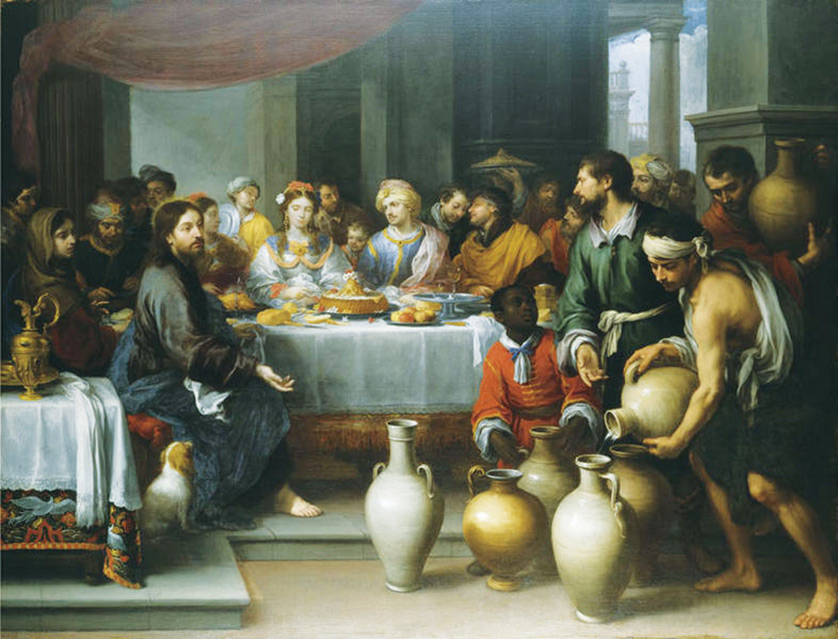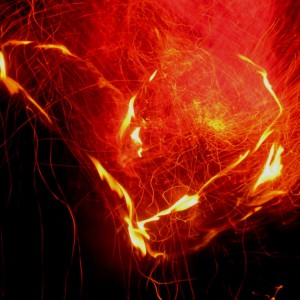One glaring omission from my book The Mystery of Marriage is any mention of Jesus’ first miracle at the wedding in Cana.
If I ever get a chance to publish a new edition of that book, I hope to include some version of the following, an epithalamion which I wrote originally to celebrate the wedding of my friends Andrew and Bethany. (An epithalamion is a piece written in celebration of a wedding, usually in poetry, but this one’s in prose.) You can also listen to an audio version of my talk here.
I’ll begin with one word: WED. It is such a strong word, I think, richer and more potent than any of its synonyms (unite, join, weld, amalgamate, etc.)—a good solid Anglo-Saxon word rooted in the Germanic term for pledge. (Which reminds me, incidentally, of the first Valentine’s card my fiancée Karen gave me, a few months before our wedding, which showed two pigs at feed time in the barn, with the caption, “I pledge thee my trough.”) Yes, to wed is to pledge everything that we have and are—but beyond this, far beyond, we could not pledge at all without the initiating pledge of a supreme external power.
In the final stage of the death of a star, a neutron star is formed, as internal pressures grow so great as to merge protons and electrons into one, creating a core almost entirely composed of neutrons. When two of these extremely dense neutron stars collide, the result is a massive explosion even greater than a supernova, called a kilonova. Among the products of this cataclysm is an incredible amount—more than ten earth-masses—of gold. Indeed this is how such heavy, neutron-rich elements as gold and platinum are created. Thus, as a man and a woman stand before the wedding altar, they exchange souvenirs of one of the most powerful events in the cosmos.
Sometime in about 26 AD, Jesus Christ attended such an explosive event in Cana of Galilee, where a couple were being conjoined, all their atoms melted down and pressed together in a transformation so radical that our Savior symbolized it by transforming water into wine. Only Christ can do this; He alone can wed two people, changing them into … what? … not one new person, exactly, but one flesh, one body, one completely harmonious union of motive, action, and presence in this mercurial, material world—a platform of divine stability in a wildly unstable environment.
And this is merely the lowest level of what happened at Cana. Why was Christ’s first miracle performed at a wedding? Because the human wedding itself symbolized a far greater nuptial: the espousal of the world by the Son of God. The Apostle John placed this miracle at the beginning of his gospel in order to announce the arrival of the Messiah, which in turn signaled the mystical reuniting—the marriage—of Heaven and Earth. Since Jesus’ Father could not be physically present at this event, in a role reversal it was Christ’s mother, Mary, who in a sense “gave her Son away” with a bold statement to the household servants that is really addressed to everyone in the world: “Do whatever He tells you.” (John 2:5) Mary was giving her Son to us, to all who would follow and believe in Him, for we are the Bride of Christ.
Thus spousal love is the fundamental icon of the new covenant between God and His people, a reality Jesus Himself reinforced in a grand parable: “The kingdom of heaven is like a king who prepared a wedding banquet for his son” (Mt 22:2). Conviviality, feasting, dancing, joy—a Big Party!—this is how God the Father wishes to celebrate the union of His Son, Jesus Christ, with the world.
The Greek poet Sappho wrote a wonderful epithalamion which contains the line:
Raise high the roof beam, carpenters! Sing the wedding song!
This poem is a kind of secular equivalent—both in its theme and in its lush, erotic, extravagant imagery—to the biblical Song of Songs. It has some beautiful and arresting stanzas, such as:
Blessed bridegroom,
The marriage is accomplished as you prayed.
You have the maiden you prayed for.
Some say an army of horsemen,
some of footsoldiers, some of ships,
is the fairest thing on the black earth,
but I say it is what one loves.
I particularly love the line “Raise high the roof beam, carpenters!” for its joyous, celebratory tone, and also for its suggestion (to me) of Isaiah 54:2-3:
Enlarge the place of your tent,
stretch your tent curtains wide,
do not hold back;
lengthen your cords,
strengthen your stakes.
For you will spread out to the right and to the left;
your descendants will dispossess nations
and settle in their desolate cities.
The splitting of the atom—nuclear fission—releases tremendous energy. But much more power is released through nuclear fusion. God’s purpose in fusing a man and a woman in holy wedlock is nothing less than to “dispossess nations”—to overthrow the godless realms of this world with a new kind of army: generation upon generation of godly families who will love the Lord, do His will, and establish His kingdom.
Raise high the roof beam, carpenters!
(Once again, an audio version of this talk is available here.)
Next Post: Babies in the Bible: The Mystery of Children





